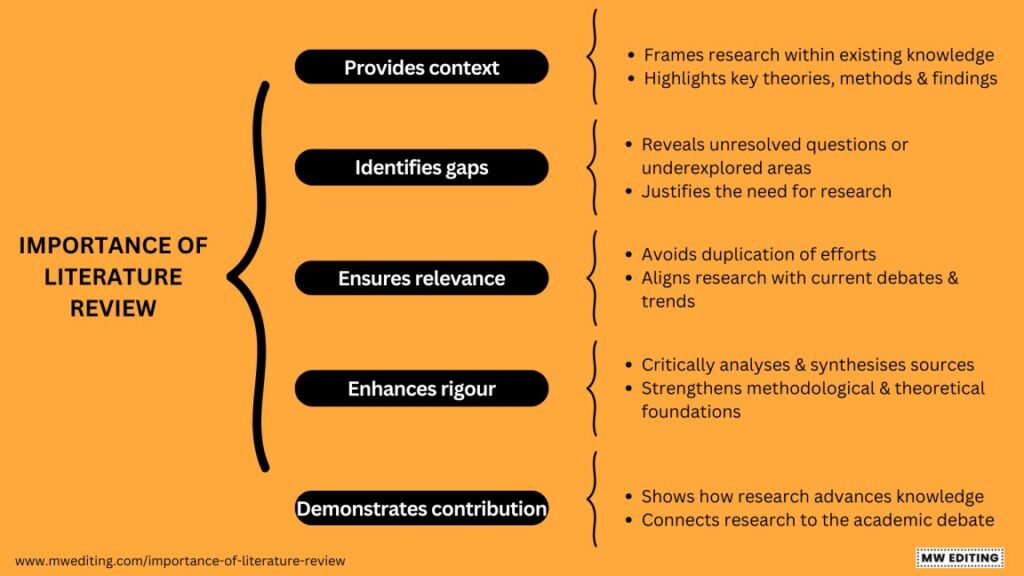The importance of literature review lies in its ability to provide a critical foundation for academic research. By synthesising existing studies and identifying gaps, it ensures that research is relevant, methodologically sound and contributes meaningfully to its field. A well-structured literature review is an essential component of scholarly work.
This blog post examines the purpose and importance of literature review in academic research. It defines what a literature review is, discusses its functions in different types of texts and outlines its key elements. The post also provides practical guidance on how to write an effective literature review and highlights the role of professional editing services in improving clarity, structure and accuracy. Additionally, it lists resources that can support researchers in developing comprehensive and critical reviews.
- What is literature review?
- Importance of literature review
- Characteristics of an effective literature review
- How to write an effective literature review?
- Texts that contain literature reviews
- Using editing services to polish literature reviews
- Resources for writing effective literature reviews
What is literature review?
A literature review surveys and critically evaluates existing research to identify trends, gaps and key findings within a specific academic field. The importance of literature review lies in establishing a foundation for scholarly inquiry and enabling meaningful dialogue within academic disciplines.
As an independent text, it summarises and analyses prior studies, offers a comprehensive understanding of the topic and guides future research. Moreover, it often serves as an independent academic document, such as in systematic reviews, to gather knowledge on a particular subject.
In academic texts like theses, monographs or research articles, literature review provides context for the research. In addition, it frames the problem, supports the methodology and justifies the study’s contribution by placing it within existing scholarship. This demonstrates how the research builds upon or parts from prior studies.
Importance of literature review
The importance of literature review lies in its capacity to ensure academic rigour, contextual relevance and meaningful contributions, making it a critical element in any research.

Contextualising research within the field
- A literature review establishes the research context by summarising existing knowledge in the field.
- It highlights key studies, influential theories and major debates to present a clear understanding of the topic’s background.
- By identifying gaps in the literature, it demonstrates the need for the proposed research.
Enhancing research quality
- It ensures that the study builds on reliable works to avoid duplication of efforts.
- The review helps researchers refine their research questions and methodologies based on prior successes or failures in the field.
- It fosters academic rigour by critically evaluating and synthesising sources.
Demonstrating academic contribution
- By comparing existing research, a literature review shows how a study contributes uniquely to the field.
- It identifies underexplored areas, emerging trends or unresolved questions and justifies the importance of the new research.
- It places the research in ongoing academic conversations, demonstrating relevance and significance.
Guiding future research
- It acts as a roadmap for the researcher, informing theoretical frameworks or methodological approaches.
- By consolidating key findings, it provides a reference point for developing new hypotheses or exploring interdisciplinary perspectives.
Supporting readers
- A thorough review helps readers quickly understand the topic’s scholarly landscape.
- It supports interested parties, including academics and practitioners, by offering insights and practical implications based on synthesised evidence.
Characteristics of an effective literature review
An effective literature review demonstrates several key components that ensure it meets academic standards and contributes to the field.
Comprehensive coverage
- It includes a wide range of relevant sources to ensure representation of major studies, theories and methodologies in the field.
- It avoids cherry-picking data by including diverse perspectives, including conflicting or marginalised perspectives.
Critical analysis
- An effective review does not merely summarise; it evaluates the strengths, limitations and credibility of the reviewed studies.
- It identifies gaps, inconsistencies and unanswered questions in the literature.
Organised structure
- It follows a clear and logical structure, often thematic, chronological or methodological, to present ideas cohesively.
- Each section transitions smoothly to ensure readability and coherence for the audience.
Relevance to research objectives
- It focuses on literature directly related to the research question and avoids unrelated sources.
- It aligns the reviewed studies with the scope, purpose and objectives of the research.
Balanced synthesis
- It synthesises findings across studies, identifying patterns, trends and consensus rather than treating sources independently.
- It maintains objectivity, ensuring a balanced representation of the literature without favouring specific authors or points of view.
Use of credible sources
- It relies on peer-reviewed articles, books and reputable publications to ensure reliability and research validity.
- It avoids over-reliance on secondary or non-academic sources.
Clear connection to the research
- It links the reviewed studies directly to the research problem, showing how they inform and support the proposed work.
- It justifies the need for the research by including it within the academic discourse.
Proper citation and ethical use of sources
- It follows academic standards for citation and referencing and avoids plagiarism by ensuring attribution to original authors.
- It adheres to ethical principles, presenting others’ ideas accurately and respectfully.
How to write an effective literature review?
Writing an effective literature review involves careful planning, critical analysis and clear organisation. Follow these steps to create a thorough and impactful review:
1. Define the scope and purpose
- First, clarify the objectives of the review and its relevance to your research question or academic field.
- Determine the breadth of the review by identifying key themes, concepts and timeframes.
2. Search for relevant literature
- Next, consult academic databases (for instance, PubMed, JSTOR, Scopus) to identify credible and peer-reviewed sources.
- Include diverse perspectives, such as landmark studies, recent publications and differing perspectives.
- Record bibliographic details to ensure accurate citation.
3. Evaluate and select sources
- Critically assess the reliability, methodology and findings of each study.
- Prioritise sources that contribute significantly to understanding the research problem.
- Avoid over-reliance on secondary or outdated references.
4. Organise the review
- Choose an appropriate structure:
- Thematic: Group studies by key themes or concepts.
- Chronological: Present research developments over time.
- Methodological: Compare different research methods or approaches.
- Ensure sections transition smoothly and logically.
5. Analyse and synthesise findings
- Compare and contrast studies, highlighting similarities, differences and gaps.
- Identify trends, emerging theories and unresolved questions within the literature.
- Avoid summarising each source in isolation; focus on integrating findings to build a cohesive narrative.
6. Write with clarity and precision
- Use concise language to convey ideas effectively, ensuring readability for academic audiences.
- Maintain an objective tone by avoiding personal bias or unsupported opinions.
- Link each study to the broader research context, demonstrating its relevance to your work.
7. Reference accurately
- Follow the required citation style (for instance, APA, MLA, Chicago) to ensure proper attribution.
- Include a comprehensive reference list for all cited works.
8. Revise and polish
- Finally, review the draft for logical flow, coherence and balance in representing various perspectives.
- Seek feedback from peers, supervisors or professional editors to refine the review.
Texts that contain literature reviews
Literature reviews appear in various academic texts, either as standalone sections or integrated components. Their inclusion varies depending on the purpose and scope of the text.
Standalone literature reviews
- Systematic reviews collect and synthesise research on a specific question, often in health or social sciences, using rigorous and transparent methods.
- Narrative reviews summarise and interpret literature on a broader topic, often used to provide context or propose theoretical frameworks.
- Meta-analyses combine statistical findings from multiple studies to draw quantitative conclusions about a research question.
Integrated literature reviews
Theses and dissertations
Theses and dissertations include a dedicated chapter that frames the research question, justifies its relevance and places the study within the existing body of knowledge. The literature review demonstrates the academic contribution and provides a basis for the research methodology.
Research articles
In journal articles, literature reviews typically appear in the introduction or a separate section. They provide background, highlight gaps and establish the significance of the study.
Monographs and academic books
In monographs or books, literature reviews often feature in the introductory chapters to set the stage for the central argument. They may also appear in thematic sections, depending on the book’s structure.
Grant proposals
Funding applications include literature reviews to justify the proposed research by situating it within the context of prior studies. They demonstrate the novelty and feasibility of the project.
Conference papers
Conference presentations or proceedings often incorporate literature reviews to outline the relevance of the discussed research.
Policy reports and white papers
Reports and white papers may include reviews of existing research to inform evidence-based recommendations or contextualise findings.
Using editing services to polish literature reviews
Professional editing services refine literature reviews by improving clarity, structure, coherence and language quality. Different types of editing services — developmental editing, line editing, copyediting and proofreading — address specific aspects to ensure the review meets high academic standards.
Developmental editing
Focus: Overall structure, coherence and logical flow
A developmental editor examines the review’s organisation, ensuring sections follow a logical order (for instance, thematic or chronological). In addition, they suggest improvements to the depth of analysis and highlight gaps in synthesis or argumentation. This service ensures the literature review effectively contextualises the research and connects ideas seamlessly.
Line editing
Focus: Sentence-level clarity and stylistic consistency
A line editor improves the readability of the review by rephrasing awkward sentences and enhancing transitions between ideas. Moreover, they ensure terminology and tone align with the intended audience, avoiding jargon or ambiguous phrasing. This service enhances the overall flow, ensuring the review conveys complex ideas clearly and concisely.
Copyediting
Focus: Grammar, syntax and formatting
A copyeditor corrects grammatical errors, punctuation issues and stylistic inconsistencies. They ensure adherence to academic writing conventions and formatting guidelines (for example, referencing styles like APA, MLA or Chicago). This service ensures the literature review appears polished and professional, meeting institutional or journal standards.
Proofreading
Focus: Final checks for typographical errors and minor inconsistencies
A proofreader ensures no residual mistakes, such as spelling errors, misplaced commas or formatting issues. This service is the final check before the text is published.
Benefits of professional editing for literature reviews
- Enhanced clarity and readability: Editing ensures the review communicates ideas effectively, improving comprehension for academic audiences.
- Improved structure and organisation: Editors refine the flow and arrangement of sections, highlighting key arguments and transitions.
- Consistency and adherence to standards: Professional editing ensures compliance with academic style guides and formatting requirements.
- Error-free presentation: By eliminating errors, editing strengthens credibility and professionalism.
Resources for writing effective literature reviews
- Academic Writing Amplified podcast, hosted by Dr Cathy Mazak, offers strategies for academic writing productivity and navigating the academic publishing landscape.
- Conducting Research Literature Reviews: From the Internet to Paper by Arlene G. Fink focuses on synthesising research literature and offers strategies for efficient reading and organisation.
- Systematic Approaches to a Successful Literature Review by Andrew Booth, Anthea Sutton, Mark Clowes and Marissa Martyn-St James provides comprehensive guidance on planning, conducting and reporting literature reviews, including worksheets and decision aids.
- The Graduate Writing Guy provides insights and tips on crafting effective literature reviews, including recommended books and strategies.
- Writing the Literature Review: A Practical Guide by Sara Efrat Efron and Ruth Ravid offers a step-by-step approach to conducting and writing literature reviews, with practical examples and organisational tips.
Key takeaways
The importance of literature review extends beyond summarising existing research; it ensures that studies are firmly grounded in academic discourse. By applying the strategies discussed and leveraging appropriate resources, researchers can produce reviews that enhance the rigour and relevance of their work.
Contact me if you are an academic author looking for editing or indexing services. I am an experienced editor offering a free sample edit and an early bird discount.


